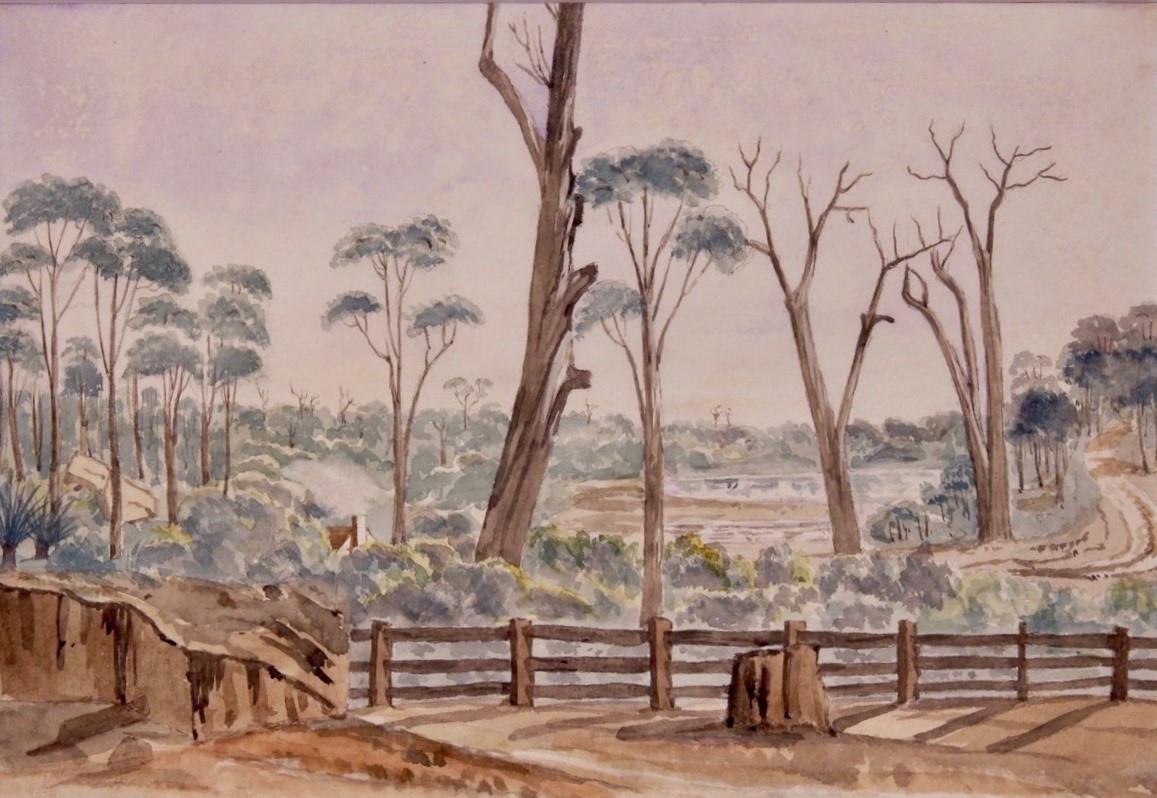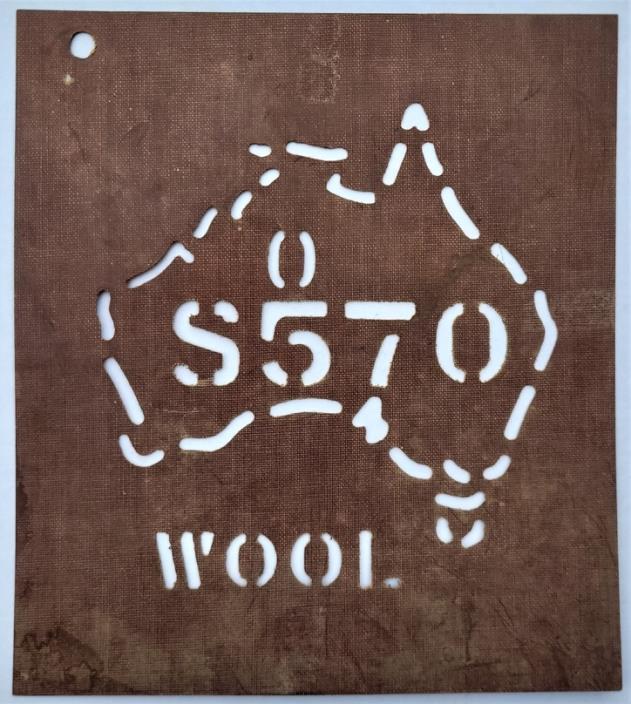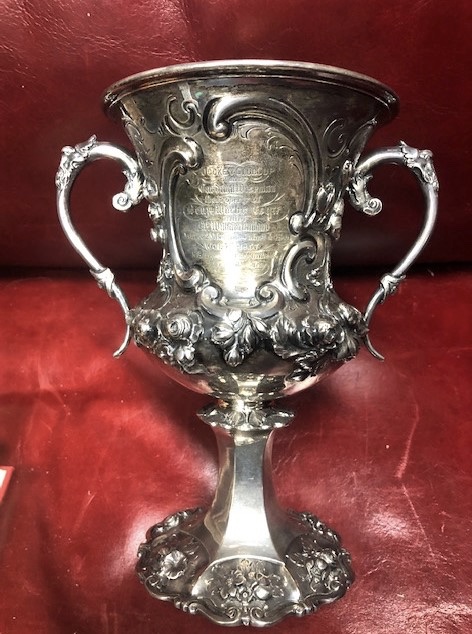1
Something Lost Something Found
Watercolour near The Glebe Sydney James Coutts Crawford, Size 260 x180 cm
In the August 2020 Australiana we [Robert and Peter] wrote an article about an amateur 19th century artist, James Coutts Crawford, living in Glebe, Sydney in 1844-45. Some watercolour scenes of Glebe from that time had “gone missing” and our article explained why the pictures were important to us as local historians in documenting the early history of our suburb. We had previously purchased one that we had been able to track down. Only having State Library high gloss black and white photographs of others we were eager to seek any leads from Society members in locating originals to purchase or better reproduce
.
It pays to keep your eyes on auction sales and as other collectors know perseverance and time sometimes pay off as the excitement of locating a piece or better example forms a large part of why we all keep collecting. Surprisingly when viewing a recent Melbourne auction other members who had read our article contacted us to ask if we had seen the catalogue and if the lot was something we were after. Indeed it was and thanks to eagled eyed fellow members!
We were successful at auction and when reframed it will become a pair to our earlier purchase. From the State Library portfolio and written in old hand on the back of the picture, near The Glebe Sydney, we have been able through our knowledge of local topography to further identify its exact perspective. Only six more to locate!
2
Australian lady’s silver topped walking stick
Silver topped walking stick with the head of a woman wearing a hat, with the words ‘T. Telesforo Priora 48 & 50 Park St, Sydney’ engraved on it. Total length approx. 88cm
The walking stick was made and probably used by Telesforo Priora. His name and address was recorded on it in case it was misplaced. The model of a woman’s head with the fashionable hat is most likely a generic image, not a likeness of a particular person.
Italian born Telesfero T.P. Priora, and his brothers John, Ernesto and Amilcare were jewellers, diamond setters and silversmiths who created unique and unusual designs from their workshop at 48-50 Park St, Sydney from 1884 to 1909.
Telesfero died in 1902, thus the date range for the manufacture of the walking stick is between 1885 and 1902. In 1890 the shop was robbed and it was reported £600 of goods were stolen. The brothers often sold their goods to retailers like W.J. Proud and E. Butcher & Co. who had their retailers mark stamped on them.
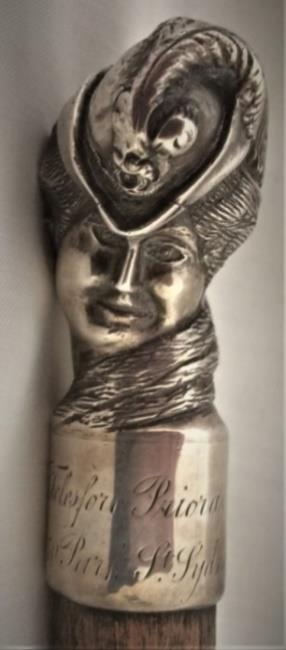
Shortly after Telesfero died his widow and children gave a complimentary concert at the YMCA Hall in Pitt Street and invited all Italians in sympathy to attend.
In 1906 John and Ernesto became Australian citizens and their naturalization papers reveal Peter John Baptist (known as John) was born November 1854, at Mortara, in the Province of Lomellina, northern Italy, arrived in Australia in March 1882 from Milan [died Sydney 1938] and Ernesto was born July 1856 also at Mortara, and arrived in Australia in November 1879 [died 1936]. Amilcare died in 1910 in Sydney.
Italians in Sydney: In 1879 the Great International Exhibition was held in Sydney, with the participation of 50 Italian firms. Typical products exhibited were marble statues, mosaics, straw hats, wines, liqueurs, preserved fruit and machinery for the manufacture of pasta and the production of oil. The highlight of the closing ceremony of the Exhibition was the performance of the hymn Australia, composed by Milanese maestro Paolo Giorza. The 1901 Census registered the presence of 5,678 Italians in Australia. Of them, 915 lived in Sydney.
When the brothers arrived in Sydney in the 1870s and 80s many Italians were political refugees and the Italian community had some 500 people. Whether the Priora brothers were political refugees or simply sought better financial opportunities is not known.
Notes: The Priora business is recorded in Australiana February 2001, Vol 23-1 Cavill, Kenneth ‘Genesis of the Riverview Gold Challenge Cup’ and Gold & Silversmiths, Makers & Marks by Cavill Cocks & Grace, C. G. C. Gold Ltd, Sydney 1992. P 190. Ros Maguire wrote on ‘Italian jewellers in NSW’ in Australiana August 2004.
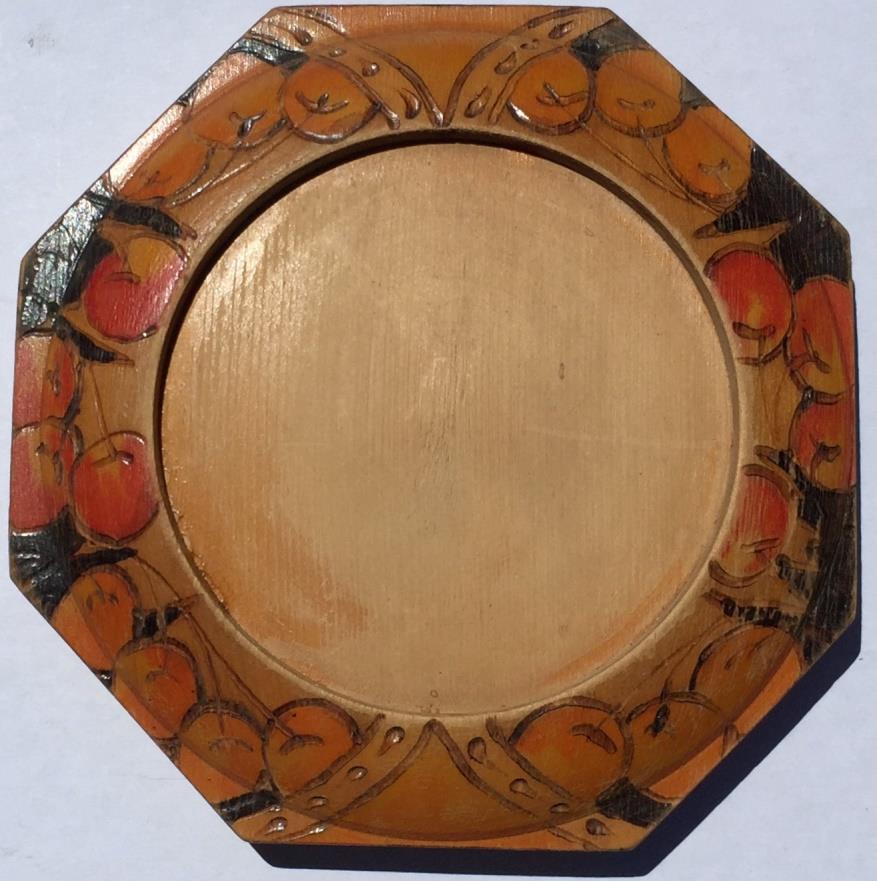

3
Pokerwork: octagon cheese plate and knife c 1930s
Timber: pine. Size: plate 15 x 15 cm. knife: length 22.2 cm
Pokerwork is also known as pyrography, and the process involves burning designs on wood and is often coloured like this example. Pokerwork is predominantly a cottage industry in Australia, and was often made to supplement income. This art form was practised by a variety of people at differing skill levels so the quality of pieces varies widely. Most homes between Federation and up to World War II had at least one pokerwork ornament or decorated utilitarian object. Circular plates with a drop-in centre were used as bread boards.
Whilst these two pieces are not signed, which is more often the case, the knife depicts a waratah (Telopea speciosissima); which strongly suggests it was made in New South Wales. The two items were acquired by the current owner in that state. The knife predates the waratah becoming the official floral emblem of NSW, which was proclaimed on 24 October 1962.
Editor’s Notes: Aboriginal people have for millennia produced pokerwork and their current work is readily available where their art is sold.
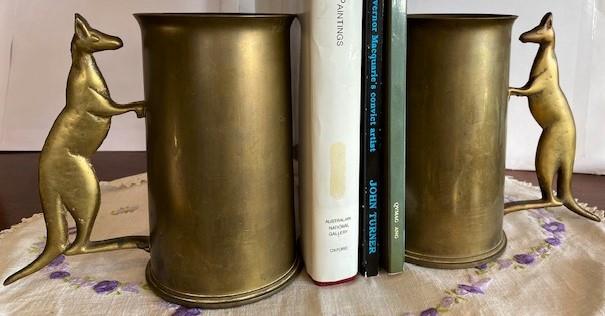
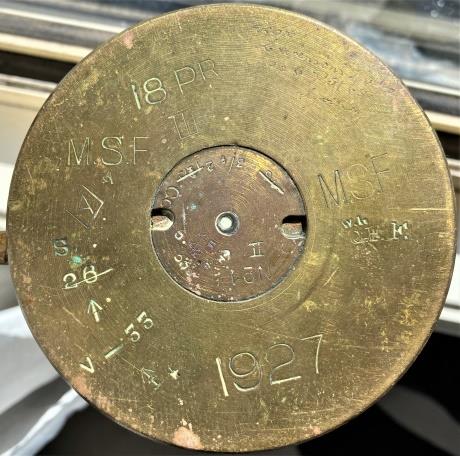
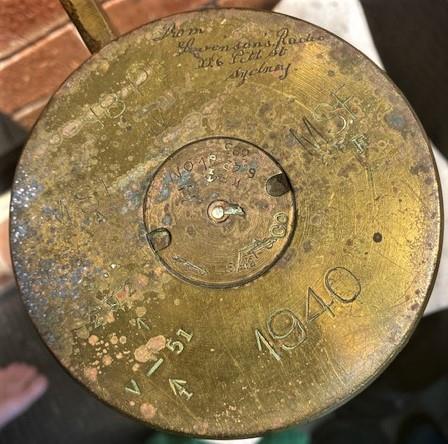

4
Trench Art kangaroo bookends
This pair of war souvenirs made from 18 pounder brass shell cases with kangaroo handles is used as bookends. The shells were made in 1927 and 1940 and bear the initials of the maker ‘M.S.F.’. Both shells have been engraved on the base; ‘From Levenson’s Radio 226 Pitt St Sydney’. Measurements: H 16.6 cm. D 10.5 cm. Kangaroo: H 15cm. W 8.5 cm. includes tail
During war time artillery brass shell cases were returned to munitions factories for refilling numerous times, and each time additional marks were stamped into the base. At the cessation of hostilities after the First and Second World Wars many shell cases were scavenged and sold to people who transformed them into decorative objects. Most decorated shells were sold in pairs and placed on mantle pieces in homes. As such the date of creating this souvenir would be the latter half of the 1940s. The maker of this souvenir is unknown.
There are a number of similar pieces known, but it appears that examples with the provenance of ‘Levenson’s Radio’ are rare. As the engraved wording simply states the business name and address it appears that the decorated shell cases were most likely given to a valued client.
Levenson’s business was in existence from 1920s to the late 1960s and was run as a family business headed by Joe Levenson. The firm had their own radio brand, and sold Australian and imported radios and radio parts.
5
The Bunyip Cup
On 19 December 1863, a group of gentlemen gathered at the Globe Inn in Adelaide, for the purpose of establishing a society for the encouragement of the breeding of poultry. At the meeting it was resolved to establish a society to be called the ‘South Australian Poultry Society’.
At the Society’s annual general meeting held in May 1887, several alterations were made to the rules and it was decided that the Society, in the future, would be known as the ‘South Australian Poultry and Dog Society’, the name of which was change to the ‘South Australian Poultry and Kennel Club’ at the annual general meeting in August 1901.
The Society is recognised as the oldest Poultry and Kennel Club in South Australia, and is still operating to-day.(1)
The soap factory that became known as the ‘Bunyip Soap Companyʼ was set up on 53 acres (21 ha) to the south of Port Pirie, South Australia, in 1878, by Joseph Crompton. In 1889, under the management of J. Milbourne, the factory was relocated to Winwood Street, Southwark (now Thebarton) on the banks of the Torrens River, into premises previously occupied by T. Cornish’s tannery. The name ‘Bunyip Soap Companyʼ was registered in 1898 and in 1954 it began trading as ‘Crompton Bunyip Soaps Ltdʼ until 1991 when the firm went into voluntary liquidation. (2)
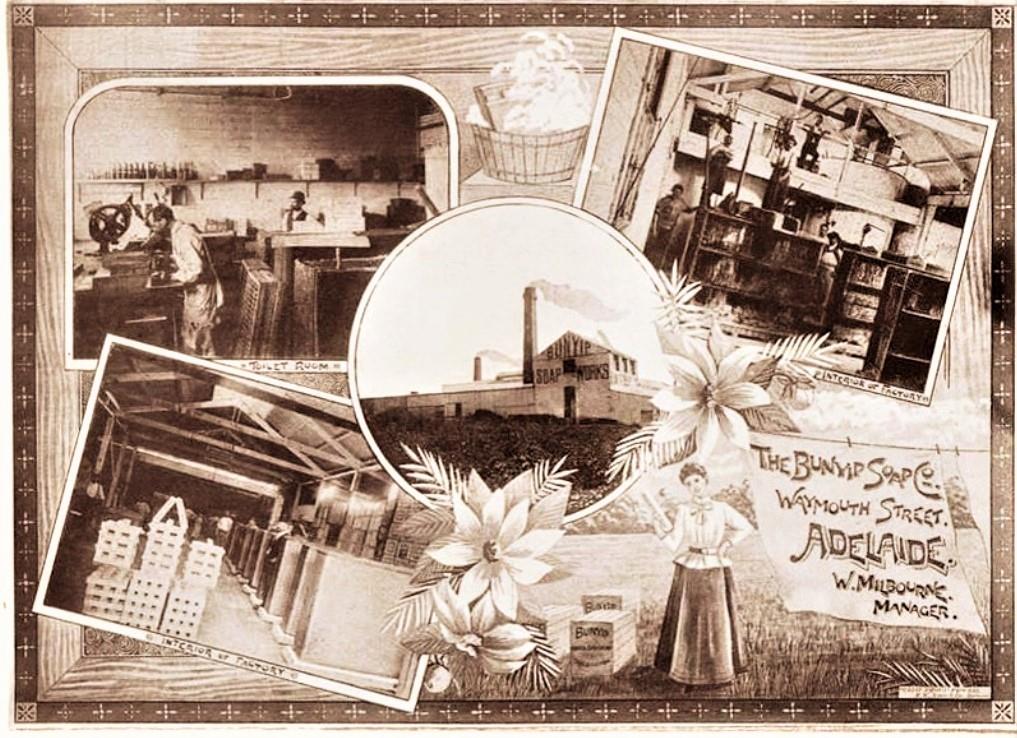
This post card of the Bunyip Soap Co. was produced c. 1910 and shows the factory inside and out.
John Richard Reedman, born in Walkerville, Adelaide, in August 1886, trained as a blacksmith.3 After marrying Elsie May George in Kensington in April 1911,4 and returning from active service in the first World War,5 by 1921 they were living in premises at 30 Tyne Street, Gilberton,6 where John set up a chook coop in the backyard to supplement their diet. (5)
Raising and caring for these chooks soon turned into a hobby for John, who began entering them in competitions. At the Royal Show in September 1928, his pullet won the Poultry Section, Heavy Breeds. (7)
This was followed over the next few years by a number of winning entries for his Sussex pullets and the number of eggs laid at various Shows around the State.8
In July 1930, John entered his chooks in the 56th championship show held by the South Australian Poultry and Kennel Club at the Wayville Showgrounds. The challenge trophy offered by the Bunyip Soap Co. for the whitest fowl, which had to be won twice, became the property of Mr. J. R. Reedman of Gilberton, who won for the second year in succession.(9)
John was then presented with this little 11.5 cm high silver-plated trophy engraved: ‘THE BUNYIP CUP presented to The S. A. Poultry & Kennel Club by The Bunyip Soap Co. Ltd.’ and on the reverse: ‘TROPHY FOR The Whitest Fowl won by J. R. REEDMAN. 1929 – 1930.’
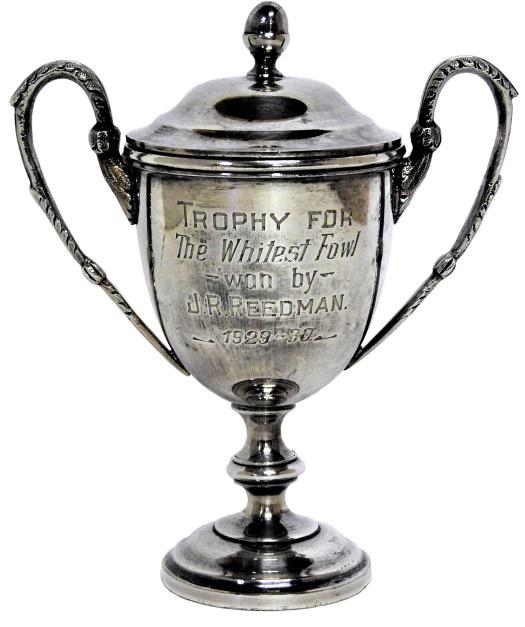
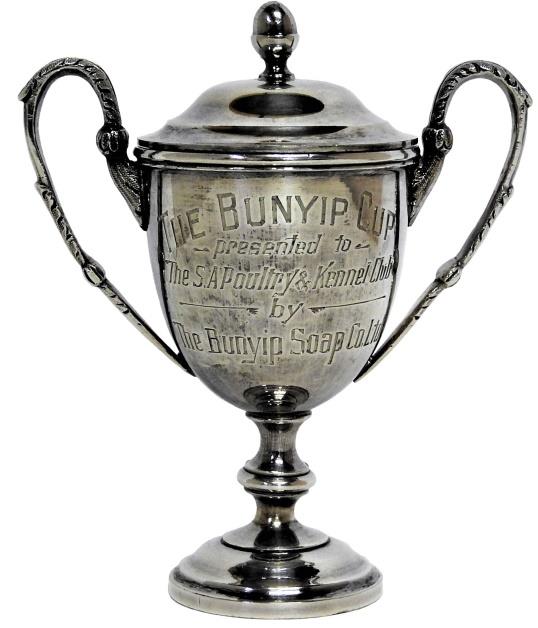
John continued showing his chooks at various Shows, the last being the Royal Show in September 1935, when his Hen and Cockerel won their sections.(10)
John Richard Reedman died at his residence in Tyne Street, Gilberton, on 2 December 1935, at the early age of 49.(11)
This little trophy was in a box of bits and pieces among other things (pottery) acquired at an auction in Adelaide in 1984 by Geoff and Kerrie Ford, who after reading ‘Trophy for the whitest fowl presented by The Bunyip Soap Co. Ltd.’, which conjured up an image of someone scrubbing a chook with a bar of soap before entering it in a show – although not Australian pottery – added it to their collection, see australianpottery.net.au.
1. South Australian Poultry and Kennel Club Facebook page
2. wikipedia.org/wiki/Crompton and Sons, History
3. Australia, Birth Index, 1788–1922, John Richard Reedman Vol. No. 381 p 197
4. Australia, Marriage Index, 1788–1950, Reedman/George Vol. No. 247 p 263
5. National Archives of Australia WWI Service Records, 1914–1920, Service No. 13375 6. 1921 Sands & McDougallʼs South Australian Directory, John Reedman, p 1462
7. Register 12 September 1928 p 19
8. Register News-Pictorial 22 April 1929 p 25, 4 June 1929 p 36; Chronicle 16 May 1929 p 12; Mail 6 July 1929 p 10
9. Advertiser 21 July 1930 p 11
10. Chronicle 19 September 1935 p 28
11. Australia, Death Index, 1787–1985, John Richard Reedman Vol. No. 576 p 5025; The Advertiser 4 December 1935 p6
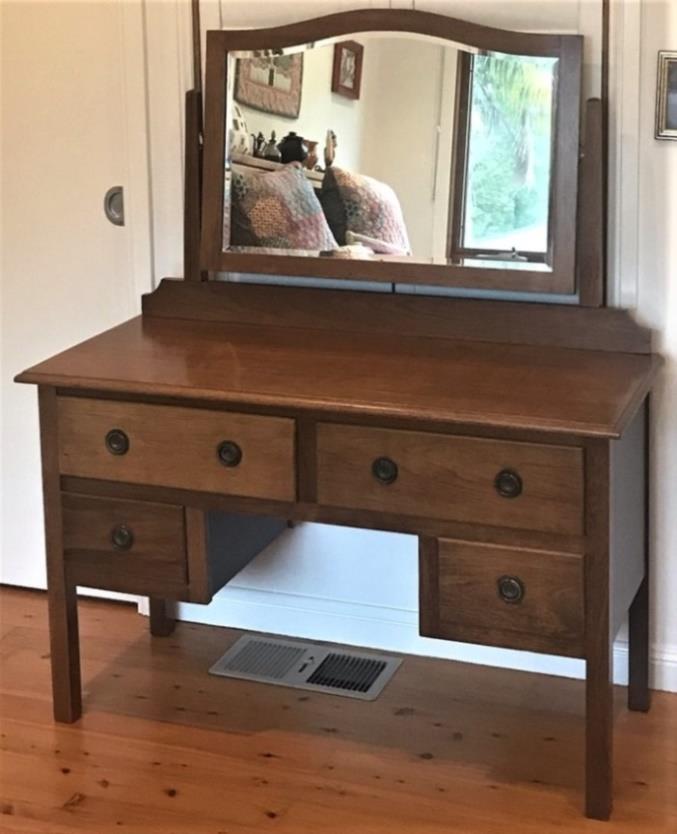
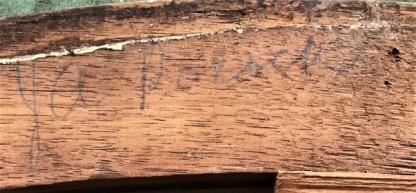
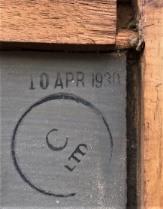
6
Dressing table made by J.A. Pocock of Mile End, SA, c1930
Timber: Australian Oak with Blackwood side panels. Plywood was used for internal components and backing of the mirror. It was made during the Depression, so the furniture maker used timber that was available, and the dark stain gave a uniform appearance. Size: height 145 cm. width 122 cm. depth 50 cm
The dressing table was part of a three piece bedroom suite and is a family heirloom. The bed was discarded in the early 1970s and the dressing table and the cabinet were acquired by a grandson. In recent times the dressing table, being no longer required by the grandson, was given to Colin Lane, another grandson. Colin restored it and during restoration he discovered the maker’s name in pencil, ‘J.A. Pocock’, and the mirror’s maker’s mark; ‘C LTD’ within a circle, and the date ‘10 Apr 1930’. A newspaper search in Trove revealed the maker had his factory situated at the corner of Falcon Avenue and Tarragon Street, Mile End, an inner western suburb of Adelaide. In 1937 the factory was destroyed by fire with the damages estimated to be £2,800. Little is known about J.A. (James Alexander) Pocock, except that in 1911 he was given an Honorary Mention in a Manufacturers’ Essay Competion and he attended Thebarton School. The C in the mirror stands for Clarkson, a glazier and paint suppliers of Adelaide.
This solved a family riddle – had it been brought out to Adelaide from England when the family arrived or was it purchased locally? The orginal owners, Jim and Maud Edmonds arrived in Australia in 1920 with their four children, and in 1922 they had another child, Beryl who turned 99 in November this year. Jim had served in the British Army during WWI and in Adelaide he had a business on the Norwood Parade repairing motor car canvas hoods. They lived in a number of small rental cottages within two kilometres of his business. Jim died in 1956 and Maud in 1970 and both are buried at Centennial Park.
Editor’s comment: The Clarkson business was established in 1848 and originally traded as H.L. Vosz, the founder’s name. In 1915 the business changed to Clarkson, named after one of the senior employees, Albert Ernest Clarkson, in response of the anti-German feeling at the time. One of the founder’s sons, Adolph Frederick Emil Vosz bequeathed his coin collection in 1868 to the South Australian Institute, and that collection now forms part of the numismatic holdings held in the Art Gallery of South Australia.
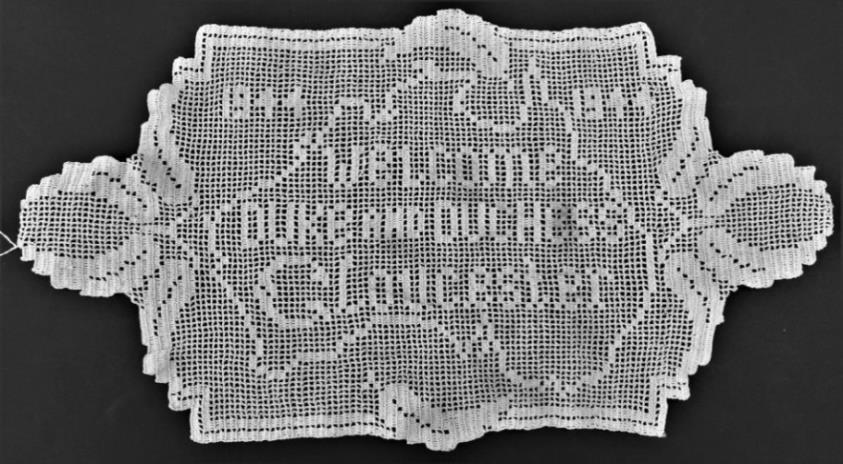
7
Crochet welcoming the Duke and Duchess of Gloucester to Australia in 1944
Description: WELCOME DUKE AND DUCHESS GLOUCESTER within a map of mainland Australia, above and below a gum leaf, left and right of the map, the date, 1944, left and right a waratah flower. Size: 51 x 25 cm
The pattern for this piece appeared in the Australian Women’s Weekly on 14 October 1944 and was repeated on 16 December 1944. The title of the article was ‘charming table-centre’ and to make the souvenir the Weekly stated that one ball of Mercer cotton No. 70 and one steel crochet hook size 6 was all that was needed.
George VI’s brother, Prince Henry, The Duke of Gloucester (1900-1974), first visited Australia in 1934 to attend the centenary celebrations of European settlement in Victoria, and the following year he married Lady Alice Christabel Montagu-Douglas-Scott (1901-2004). On 15 November 1943, Prime Minister John Curtin announced that the Duke would succeed Governor-General Gowrie. Curtin’s reason for choosing another British Governor-General for Australia was that he ‘thought that the presence in Australia of a member of the royal family would influence the despatch of British divisions and equipment to the Pacific’. Thus the crochet becomes something more than a mere souvenir, it became a ‘Home Front’ object that helped morale.
The Gloucesters with their two young children disembarked in Sydney on 28 January 1945, later than expected due to security measures (and hence the 1944 date on the crochet) , and two days later in Canberra the Duke was sworn in. During their two years in Australia they visited all states, Norfolk Island and Papua New Guinea. The Gloucesters left Australia on 17 January 1947.
When the Duke learnt that he was being replaced by an Australian as Governor-General, it is claimed that he said ‘Then it seems I have wasted my bloody time’ in cementing Australia’s links with the monarchy. See Sam Nichols, ‘Royal memories of Canberra’; repatriating the Duke of Gloucester’s 1946 collection Scenes of Canberra by John Eldershaw’ Australiana November 2021.
Editor’s Notes:
Tasmania has been left off the map of Australia before and after this 1944 crochet was
created. Some government, sporting and business examples since then include:
1956: Australian athletes at the Olympics, held in Melbourne, wore tracksuits that featured a
map of Australia excluding Tasmania.
1982: Commonwealth Games opening ceremony in Brisbane, hundreds of children marched around the stadium to form the shape of Australia … but apparently only the mainland.
2013: South Australia adopted a logo that omitted Tasmania.
2016: Woolworths Supermarkets were forced to withdraw Australia Day caps from sale which featured a map of Australia without Tasmania.
2019: Thins Crisps released a Pie & Sauce flavour crisps which had a map of Australia with Tasmania omitted on the package.
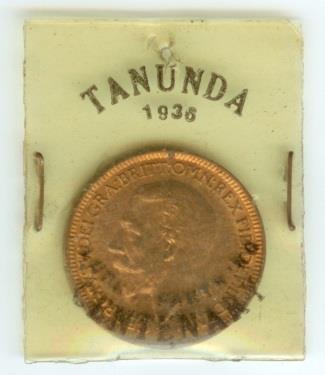
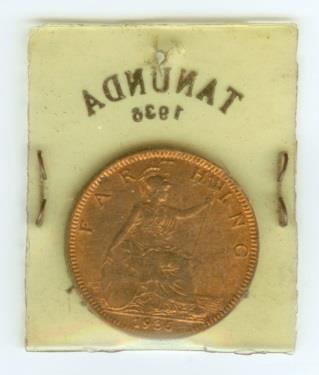
8
Tanunda 1936 Centenary Lucky Farthing
British farthing in a plastic sleeve celebrating South Australia’s Centenary
In June 1936 this ‘Farthing wrapped in celluloid with an appropriate inscription’ was sold to raise funds for the Tanunda ‘Queen of Flowers’ charity contest. Tanunda is in the Barossa Valley, some 70 kilometre north of Adelaide, and German settlers arrived there around 1842. Today it is well known for being in the heart of a wine region.
Editor’s notes:
Australia never minted farthings, but as it was a British coin it was generally accepted in the early the early years of Federation. By 1936 traders sometimes advertised their goods offering a farthing off an item.
Most readers are probably familiar with the value of a farthing, a quarter penny, and for those that are not let me tell you that they are not worth much, for example: To buy a coffee at $4.50 you would need to hand over 2,160 farthings. Mind you back in the 1930s you could by a single lolly. Do readers remember when decimal coins were first used in Australia in 1966? At the time there was an unsuccessful attempt to get the government to mint half-cents, and if they had minted the coin, you would need 900 of them to buy a coffee today! Australia’s one and two cents coins were withdrawn in 1992. America still uses one cent coins!
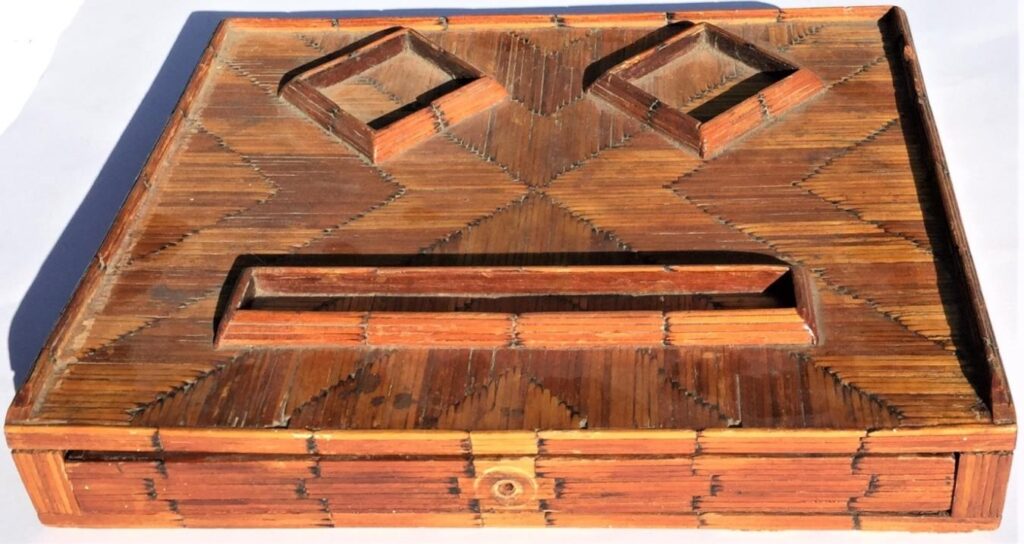
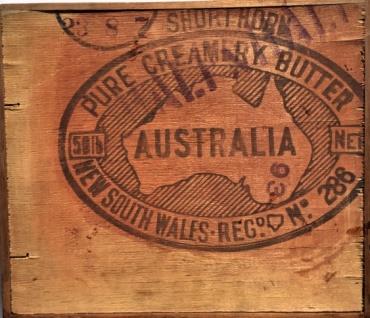
9
Inkstand made from matchsticks glued onto timber from a wooden butter box
The top has two spaces for ink bottles and a place to rest a pen. The underside of the inkstand is lined with a layer of cork. Maker unknown. Stamped on the underside of the tray: The logo of NSW Butter depicting a map of Australia with Tasmania located between ‘REG” and ‘No.’ AUSTRALIA is written across the map and around PURE CREAMERY BUTTER NEW SOUTH WALES. REGD. NO. 286. The weight 56 LB and NET at the sides. Above the logo SHORTHORN And numbers 28 8 7. Below the last A in Australia ‘93’. An illegible counter-stamp across the top of the logo.
Size: H 5.5 W 30 D 25 cm
Making things using match sticks was a popular pastime in Australia enjoyed by adults and children throughout the 20th century, in particular from 1920s to the 1960s. Makers tended to hound smokers for their used matches. Today there are far fewer smokers around, therefore the availability of used matches has greatly diminished. This fact and with the focus nowadays on electronic gadgets means that this pastime has virtually ceased.
The story of the recycled material needed to make the inkstand: Butter boxes were used for storage and to transport butter to the point of sale dating from around Federation to the mid- twentieth century. They were made from wood from indigenous and plantation timbers grown in Australia and New Zealand, and assembled with nails. The boxes were stamped with the butter factory’s brand to promote their product and as a return identification.
Matches: Whilst it is not known what brand/s of matches were used in this instance, they probably were Bryant and May’s Redheads manufactured in Melbourne, or Federal Matches made in Sydney, being the two major brands in Australia.
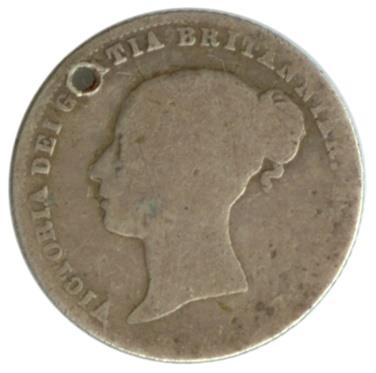
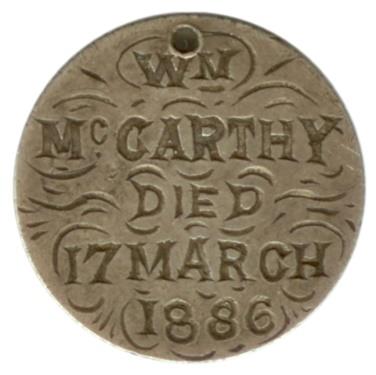
10
A silver love token lamenting the death of William McCarthy in 1886
The story of this love token is a poignant one from the Late Victorian Era of New South Wales. The named William [John] McCarthy was born in 1858, his parents were John and Elizabeth McCarthy and they stated when he died 1886 that he was single and that he was living with them at 56 Union Street Pyrmont, an inner suburb of Sydney. The host coin of the memorial love token is a Young Head (1838-1887) Queen Victoria silver shilling and it recorded that ‘Wm. McCarthy Died 17 March 1886’. William McCarthy was a compositor at the Government Printing Office and it was claimed he had a good baritone voice. William went missing on the evening of Saturday the 13th March 1886 and was found on the following Wednesday, the 17th, the date recorded on the keepsake.
William drowned under suspicious circumstances in Sydney Harbour and was found floating near Goat Island north of Pyrmont, the suburb he was last seen in. The inquest found that on the night when William went missing he had been drinking from 7.30 to 10.30pm at the Soudan Hotel, in George Street North, and had been drinking with his long time workmate William Kelly. Both left the pub together and McCarthy subsequently fell on the roadway and Kelly helped him into cab in George Street. William Pearce, the cabman took him to his home in Union Street and the cabbie never saw him again. Pearce asked for his fare, and McCarthy gave him two shillings, his legal fare was three shillings, but as McCarthy appeared to be dazed he did not press him for the full amount; at about a quarter to 11pm he drove off and returned to town, leaving the deceased still inside the property gate. Pearce did not knock at the front door, because he thought the William was all right; it was a dark night, with a strong wind blowing, and the streets were wet and slippery.
When William McCarthy’s body was recovered his watch and chain and other articles were found with him and the watch had stopped at seven minutes to twelve o’clock. Dr Eichler the coroner, stated death was caused by ‘asphyxia from drowning’. William died intestate and in April 1886 his worldly possessions were inherited by his father.
As William was unmarried, and Jane his only known sibling had died in 1871 his parents probably would have arranged for the coin to be engraved as a keepsake from a local silversmith. It may have been worn as a brooch by William’s mother or more likely that his father put it on his fob chain which in those times small gold and silver medals were frequently attached to the chain. His mother died in 1891 and his father in 1893.
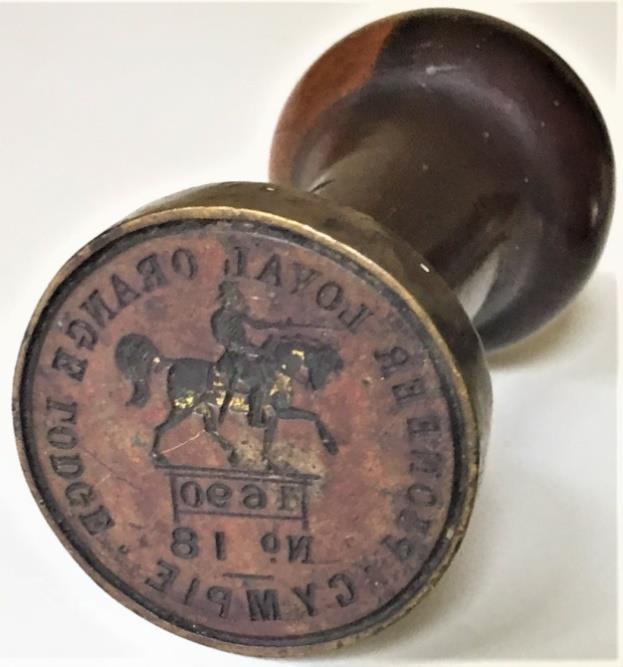
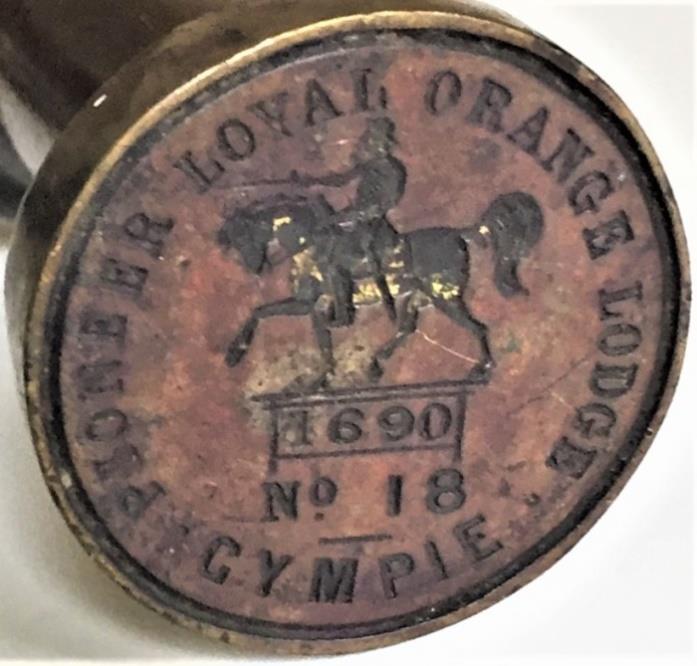
11
Pioneer Loyal Orange Lodge seal
Pioneer Loyal Orange Lodge Gympie No 18 seal. The right image has been inverted to illustrate how the seal would look on a document. Brass and Timber (Mulgawood). Total length 10 cm, diam of seal 4 cm.
The Loyal Orange Lodge was established in 1795 in Ireland, and the first lodge in Australia was in 1845. The first one in Queensland was in 1867 and the earliest ‘Trove’ reference to the Gympie lodge is July 1873 and the article mentioned the Orangemen’s motto is “Defence, not Defiance”. The origin of the prefix ‘Pioneer’ is unclear. The Orange Lodges were a Protestant Christian fraternity promoting the ideals of the Protestant faith & culture and anti-Catholic.
The rise of Orange Lodges in Australia: When Henry James O’Farrell, a Fenian sympathiser, attempted to assassinate the Duke of Edinburgh at a Sydney beachside gathering in March 1868 it sparked a dramatic rise of the Orange Order in Australia. By 1876 there were 19,000 Orangemen in over 120 Lodges.
Today the Orange order has virtually disapeared in Australia and commerating the ‘Battle of the Boyne’ with marches appears to have long ceased whilst St Patrick’s Day is still a large and popular cultural celebration.
Australia’s national anthem, Advance Australia Fair was written by a member of the Loyal Orange Lodge in NSW and he, Peter Dodds McCormick (1834-1916) first performed it on 12 July 1878. The 12th of July being the date of the ‘Battle of the Boyne’ the key date in the Orange Lodge.
Gympie’s name derives from the Gubbi Gubbi word gimpi-gimpi, which means “stinging tree” and refers to Dendrocnide moroides. The tree has large, round leaves that have similar properties to Stinging nettles. The city was previously named Nashville, after James Nash, who discovered gold in the area in 1867. The name was changed to Gympie in 1868.
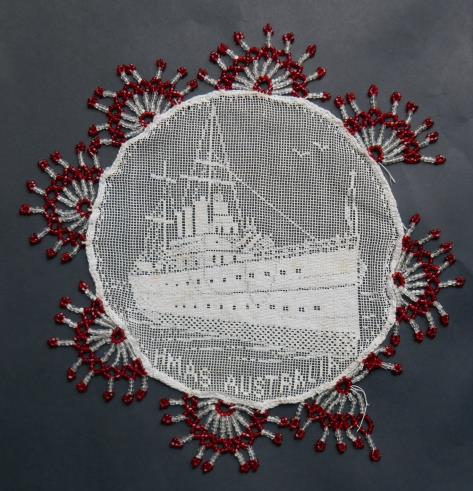
12
HMAS Australia Milk Jug Cover
Jug cover depicting HMAS Australia with attached border of eight red and white beaded motifs. C 1928-1950’s, Maker unknown. Size: 20cm. centre piece 13.5 cm diam.
The machine-made filet lace centre shows a cruiser, the HMAS Australia II. Some crew stand at the rails, gentle waves ripple around the hull and two birds soar above, an elegant representation of one of Australia’s great ships. The red and white beaded edging, sadly somewhat damaged, has eight semi-circular groups which are tightly crocheted to the circular piece. The arrangement of the beads bears a strong resemblance to the Australian Army’s iconic Rising Sun Badge. The jug cover was bought on eBay where the seller stated that it had belonged to their grandmother however the seller was unable to provide any further information. The most likely years it was made are 1927 or 1928, first when she was launched by Dame Mary Cook, wife of the Australian High commissioner UK, or when she was officially commissioned at Clydebank Scotland in April 1928 or more probably later that year when she arrived in Sydney and seen by 25,000 sightseers.
She was a RAN County Class heavy cruiser from 1928 to 1954 and was affectionately known as ‘The Aussie’. Her WW2 ‘career’ saw her serve from Africa to Norway, from the Azores to the Philippines. Berthed in Liverpool, in December 1940, for a refit, her presence was mentioned in Lord Haw Haw’s radio broadcast presaging the heavy bombing of the city. While the ship and its crew escaped major damage it was said that its cats fled the ship in the horrendous incendiary blitz which lasted for several days. Murders are rare in the Navy but in 1942, shortly before the Battle of the Coral Sea, a seaman was murdered on ‘The Aussie’ by two shipmates. Tragic for the victim, this event created a serious predicament on several fronts. It occurred at a difficult time in the war, just after Japan entered the war and the bombing of Darwin had occurred, and Curtin, the Australian Prime Minister was in conflict with Winston Churchill about bringing troops home to defend Australia. Compounding this, the RAN was still under British control and the guilty parties were subject to a British military trial which would have meant them being condemned to death (akin to Breaker Morant’s execution in the Boer War). Also the Navy had a horror of the stigma of homosexuality which is believed to have been the cause of the fight.
She did not suffer severe damage until the last months of the war when it was attacked by what appears to be suicide Japanese planes in the battles to relieve the Philippines. After the war she went into the Reserve until July 1950, she was used to do a mercy dash to Heard Island, Australia’s Antarctic base to rescue the station’s ill doctor. In 1954, she was an escort for the Queen’s visit to Australia before being decommissioned later that year and then scrapped in 1956. HMAS Australia II had sailed nearly 500,000 miles between 1939 and 1954.
Her predecessor HMAS Australia I (1909-1924) once the pride of the new young nation and its Navy had been scuttled off Sydney in 1924 with full military funeral honours. Both were built in Scotland and paid for by the Australian people.
I have found two other HMAS Australia II jug covers using similar machine-made centre but each with different edging. The Australian War Memorial Collection (REL41822) has one labelled ‘Patriotic Milk Jug Cover’. This is edged with ten crocheted triangular pieces, described as ‘repeating club or cross design’ each point has a triangular bead attached to weigh it down. No dimensions are given for their piece. See image below. (https:// www.awm.gov.au/collection/C1254555)
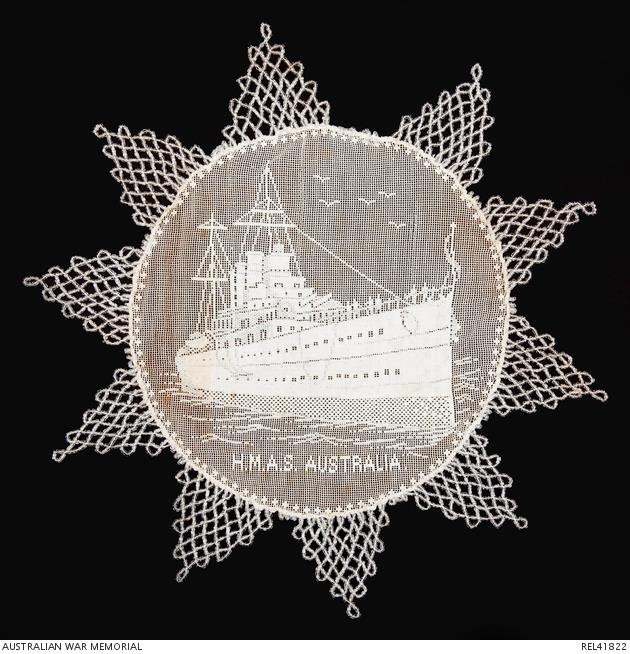
Sydney’s Museum of Arts and Applied Sciences (MAAS) also has a machine-made filet HMAS Australia II jug cover. This one has a central square shape (185 x 195mm) and blue crochet work around the edge with clusters of three round blue beads at the corners and middle of each side. (https://collection.maas.museum/object/112129) Jug covers differ from doileys (also spelt: doilie, doyly, doyley) with the use of the beads to weigh down lightweight fabric over milk jugs or sugar bowls etc. According to the MAAS commentary, jug covers became less of a necessity as household refrigerators became more common and the increased use of motor cars and rather than horses saw a corresponding decrease in the number of flies.
The Rising Sun Badge has become a potent symbol of the spirit of Anzac. The badge was selected in 1902 use by the Australian contingents serving in the Second Boer War. The radiating sun beams were based on a trophy pattern where bayonets and swords were arranged in a semicircle around a crown. The unusual beading on this jug cover bears a strong resemblance to that Badge and their red and white colouring is eloquent with red representing courage and war while white signifies purity and eternal life.
Sources: https://www.navy.gov.au/hmas-australia-ii https://navalinstitute.com.au/dark- secrets-the-true-story-of-murder-in-hmas-australia/ https://www.army.gov.au/our- heritage/traditions/rising-sun-badge https://collection.maas.museum/object/112129
Nicola Kissane
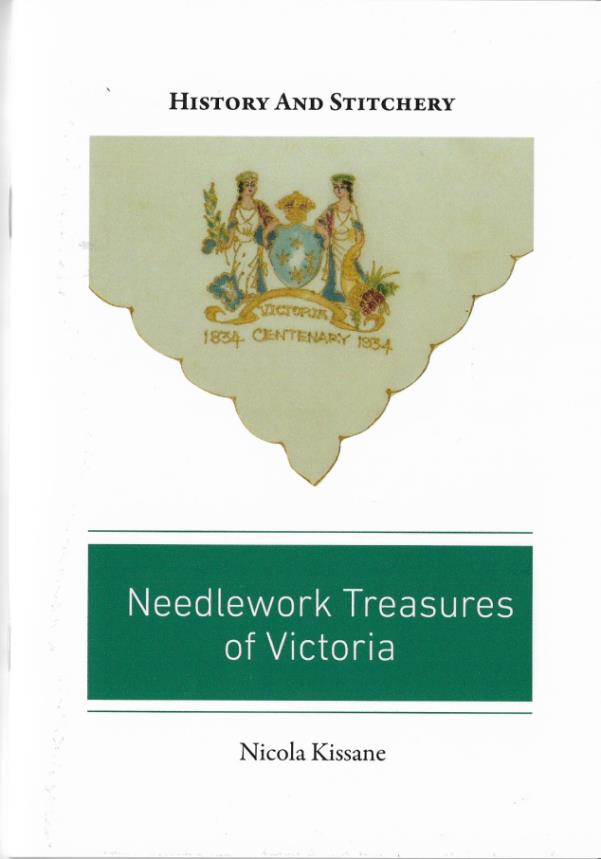
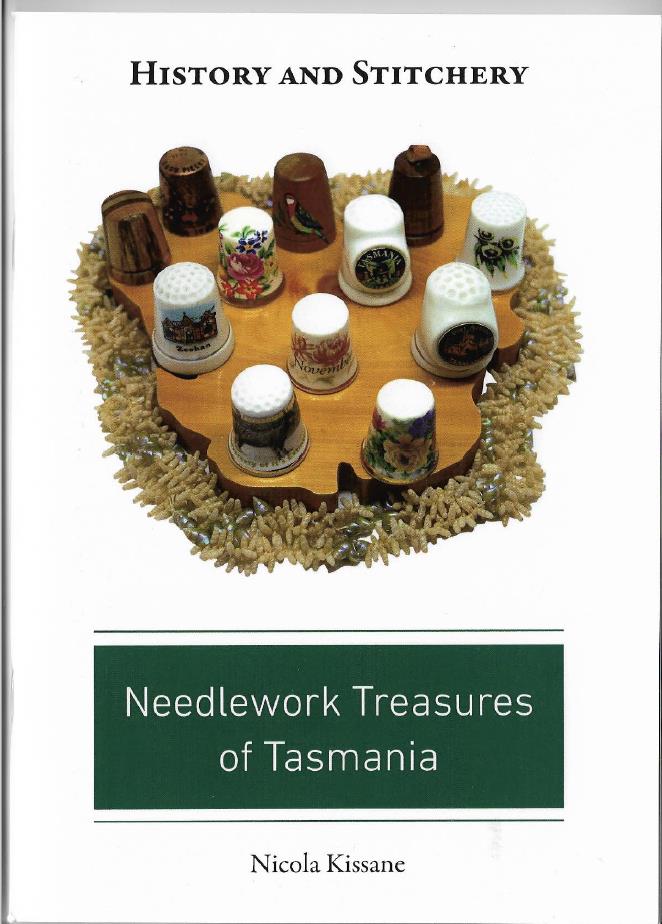
Nicola Kissane has written two books on needlework and associated tools and is offering them to Australiana Members for $40 the pair including postage anywhere within Australia, or separately at $23. Both books are 56 pages, A5, soft covered, and illustrated in colour. Enquiries contact the author at: nicolakissane@hotmail.com.
THANK YOU
The Show and Tell has been a very popular with members and was a great way to keep in contact during Covid when members were isolated and events cancelled.
The Board would like to thank Peter Lane, Yvonne Barber, David Bedford, Bob Fredman and Nicola Kissane for their efforts in collating member’s contributions.
